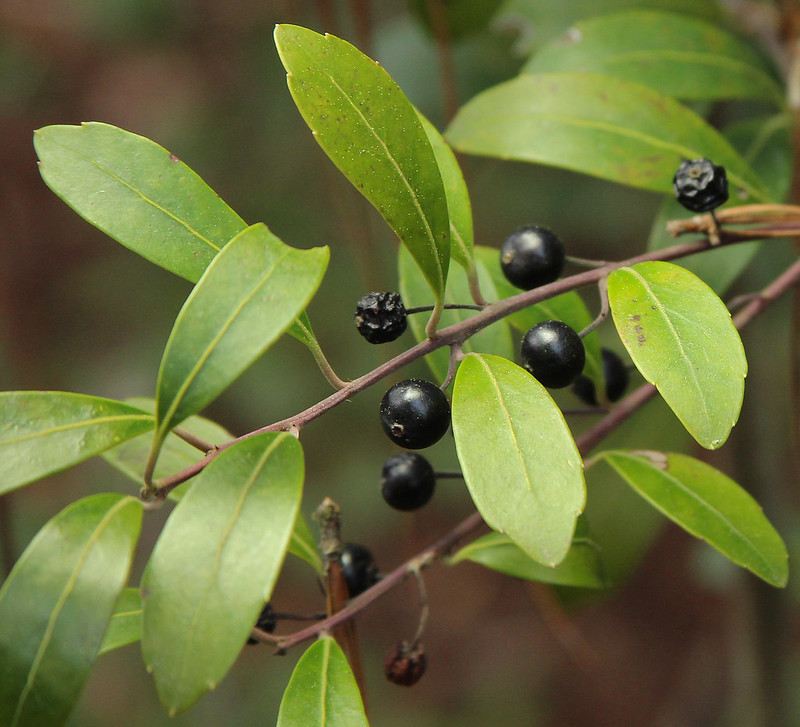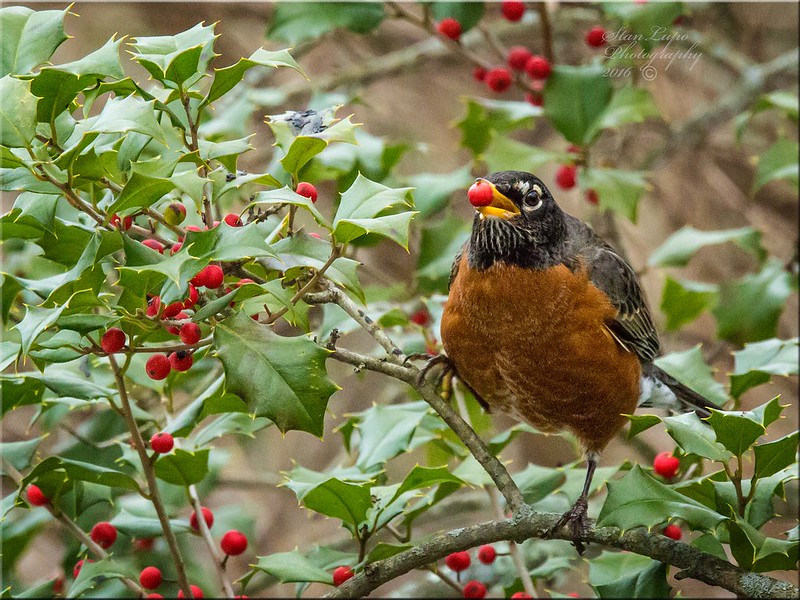Winter Greens for Wildlife
Woody plants are essential for wildlife. In the winter, evergreen plants can provide much-needed shelter and food for local animals. Consider adding one or more of these native plants to your backyard landscape to provide for local wildlife.
Inkberry (Ilex glabra)
This short-statured shrub is great for winter gardens. It typically grows 5-8 feet tall and has a spread of approximately five feet. In the winter, it sports dark black berries that take a few freezes and thaws before they become palatable to birds. This shrub is relatively slow-growing and sometimes spreads by suckers to form a colony, so take that under consideration before planting. It can be pruned to be a low hedge and prefers moist, acidic soil. It can tolerate full sun to part shade. Cultivars like Ilex glabra ‘Shamrock’ tend to have the best shape. For fruit production, be sure to get both male and female plants.
Northern Bayberry (Morella pensylvanica)
Maryland is home to three species of Morella: wax myrtle (Morella cerifera), northern bayberry, and southern bayberry (Morella caroliniensis). The latter is extremely rare while the other two are common throughout much of the coastal plain. Northern bayberry often is the easiest to find in nursery settings and sometimes is simply called bayberry. This salt-tolerant shrub can grow in full sun to part shade in well drained, acidic soils. It has a dense-branching habit and like inkberry sometimes forms colonies with suckers. The leaves are aromatic when crushed, and if cross pollination occurs, female bayberries will set waxy-blue fruits in the winter.
Mountain Laurel (Kalmia latifolia)
Mountain laurel is a lovely evergreen tree that grows up to 15 feet tall and has a spread that spans 5- 15 feet. It has broad leaves and lovely clusters of white flowers in late spring. Mountain laurel can often be seen growing in thickets in acidic, well-drained soils around Maryland. It does not do well in heavy clay, however. This plant can be used as a border plant in clumps. In rare situations, it will grow beyond 15 feet so do keep that in mind. Sometimes, it is susceptible to leaf blight, particularly during rainy, humid summers. A smaller cousin, sheep laurel (Kalmia angustifolia), can also be found in the coastal plain of Maryland. It has deep fuchsia flowers and thinner leaves than mountain laurel.
American Holly (Ilex opaca)
American holly sports spiny, evergreen leaves. It is a taller tree that can reach heights up to 30 feet and can have a spread up to 20 feet. It survives in full sun to part shade and prefers acidic, well-drained soils. In the winter, female plants can be seen with bright red berries that take a couple of freezes to become palatable to passing birds. The dense foliage is often a great roost site for birds in winter, particularly when snow covers it. Because the berries persist on the tree for a bit, they sometimes ferment. Therefore, it is best not to plant American holly close to roadsides to decrease potential issues with drunk and disorderly American robins. Like inkberry, American holly requires both male and female plants for cross pollination.
Great Rhododendron (Rhododendron maximum)
Maryland is home to several species of rhododendron, but the only evergreen species is the great rhododendron. This species can reach heights over 15 feet and can spread almost 12 feet. It has dense, broad-leaved evergreen foliage which provides excellent winter shelter for a variety of species. In late May through June, great rhododendrons will have large clusters of flowers that can vary from rose-purple to pink to white. Multiple varieties can be found in the nursery trade including cultivars that stay smaller as well as those that have rich purple flowers. This species grows best in part to full shade in moist, acidic soils.
Eastern Red Cedar (Juniperus virginiana)
This fast-growing evergreen is often used as a border plant. It can reach heights over 60 feet and can spread up to 20 feet. It has little issue with disease and is tolerant of a wide range of soil conditions. It can withstand droughts but not constant flooding. As it ages, the lower branches die back and leave a fluted trunk underneath. The dense foliage provides cover throughout the year, including great nesting habitat for species like mourning doves and roosting habitat for small owls. Eastern red cedar occasionally is susceptible to bagworms. In the winter, female plants that have been pollinated form berries that are edible to species like cedar waxwings. To get fruits, a male and female plant are needed. This species only grows well in full sun and will become sparse in shaded conditions.
Happy New Year HabiChat fans!
Winter can be a tough time of year for many of our local wildlife species. You can give them a hand by creating habitat and providing natural foods. In this winter edition of HabiChat, learn about Cedar Waxwings, a lovely resident bird that can be found in backyards, as well as our native inkberry holly that provides important cover. In addition, this issue also includes articles on Winter Greens for Wildlife, Eastern Screech Owl Nest Boxes, and how to help with the 3rd Maryland-DC Breeding Bird Atlas.
Winter is also a time for maintenance projects, so don’t forget to clean out and repair nest boxes and prune your shrubs and trees. If you are feeding birds, please also make sure to keep those feeders clean. In addition, water is crucial to many species this time of year. Consider adding a heated bird bath or pet water bowl to your landscape to help local wildlife. If you are looking for fun projects to do with the kids, why not go on a winter safari or make seed wreaths for the birds?
Finally, I am pleased to announce that we have completed the Simple School Wildlife Garden Guide. The guide contains basic information on how to start a school wildlife garden and includes suggested plants and designs for three types of gardens: a monarch garden, a songbird garden, and a pollinator garden. The guide can be found on our Schoolyard Wildlife Habitat page.
Happy Habitats,
Kerry Wixted
Click here to have HabiChat—the quarterly backyard wildlife habitat newsletter from the Wild Acres program—delivered right to your inbox!
In this Issue
Breeding Bird Atlas
Habitat Tip: Eastern Screech Owl Nest Boxes
Native Animal Profile: Cedar Waxwing
Native Plant Profile: Inkberry





 1-888-373-7888
1-888-373-7888 233733
233733